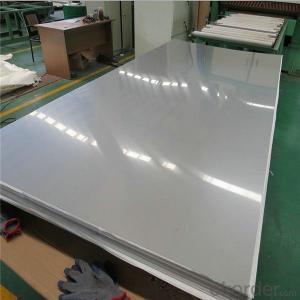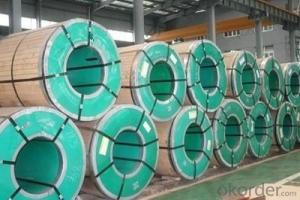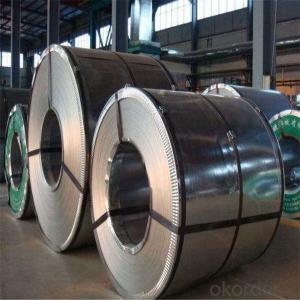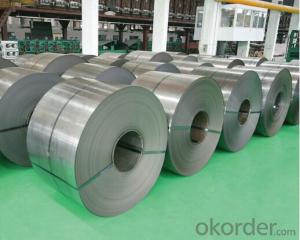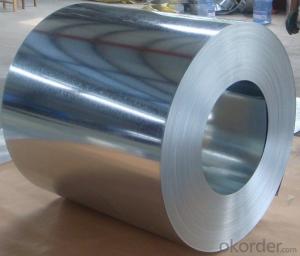Stainless Steel Coil and Sheet with Best Quality
- Loading Port:
- Shanghai
- Payment Terms:
- TT OR LC
- Min Order Qty:
- 3 m.t.
- Supply Capability:
- 100000 m.t./month
OKorder Service Pledge
OKorder Financial Service
You Might Also Like
Specification
Product Details
stainless steel sheet
Width:500-2000mm( Common width:1000mm,1219mm,1250mm,1500mm, 2000mm)
Length:1000-6000mm or as your request
Surface:No1,No4, 2B, BA, 8K, etc.
Standard:ASTM, AISI, JIS, GB, DIN,EN, etc
Materia:201,202,304,304L,304J1, 316,316L,321,309S,310S,409L, 430
Technique:Cold Rolled or Hot Rolled
Certification: ISO,SGS
Package:Waterproof paper, steel strip packed, wooden case or pack as customers requirement.
Application:Used in construction, chemical industry, electricity industry, food service industry, paper-making industry,and so on.
Payment&Shipping terms
Price | FOB USD1800-2500 per ton |
Min Qty | 5 ton we can also accept as a trail order for our first cooperation |
Port | Shanghai China or any port of China |
Packing | Waterproof paper, steel strip packed, wooden case or pack as customers requirement.
|
Delivery time | 7-10 days after the confirmation of the deposit. |
Trade terms | FOB/CFR/CIF |
Payment terms | TT/LC 30% Prepayment by T/T in advance , 70% with the copy of B/L within 3working days by T/T 30% Prepayment by T/T in advance, 70% by L/C at sight
|
Chemical composition:
TYPE NO. | C | Mn | P | S | Si | Cr | Ni | Mo |
201 | ≤0.15 | 5.5-7.5 | ≤0.050 | ≤0.030 | ≤1.00 | 16.0-18.0 | 3.5-5.5 | |
202 | ≤0.15 | 7.5-10 | ≤0.060 | ≤0.030 | ≤1.00 | 17.0-19.0 | 4.0-6.0 | |
301 | ≤0.15 | ≤2.00 | ≤0.045 | ≤0.030 | ≤1.00 | 16.5-18.0 | 6.0-8.0 | |
302 | ≤0.15 | ≤2.00 | ≤0.045 | ≤0.030 | ≤1.00 | 17.0-19.0 | 8.0-10.0 | |
304 | ≤0.08 | ≤2.00 | ≤0.045 | ≤0.030 | ≤1.00 | 18.0-20.0 | 8.0-10.5 | |
304L | ≤0.03 | ≤2.00 | ≤0.045 | ≤0.030 | ≤1.00 | 18.0-20.0 | 8.0-12.0 | |
308 | ≤0.08 | ≤2.00 | ≤0.045 | ≤0.030 | ≤1.00 | 18.0-21.0 | 10.0-12.0 | |
310S | ≤0.08 | ≤2.00 | ≤0.045 | ≤0.030 | ≤1.00 | 24.0-26.0 | 19.0-22.0 | |
316 | ≤0.08 | ≤2.00 | ≤0.045 | ≤0.030 | ≤1.00 | 16.0-18.0 | 10.0-14.0 | 2.0-3.0 |
316L | ≤0.03 | ≤2.00 | ≤0.045 | ≤0.030 | ≤1.00 | 16.0-18.0 | 10.0-14.0 | 2.0-3.0 |
321H | 0.04-0.1 | ≤2.00 | ≤0.03 | ≤0.030 | ≤0.75 | 17.0-20.0 | 9.0-13.0 | Ti4C-0.60 |
410 | ≤0.15 | ≤1.00 | ≤0.040 | ≤0.030 | ≤1.00 | 11.5-13.5 | ||
430 | ≤0.12 | ≤1.00 | ≤0.040 | ≤0.030 | ≤1.00 | 16.0-18.0 |
Surface Finish
Surface | Characteristics | Application | |
NO.1 | Finished by hot-rolling, annealing and packing, characterized by white picked surface | Chemical industry equipment, industrial tanks | |
2B | Finished by heat treatment, pickling after cold rolling, followed by skin pass line to be more brighter and smooth surface | General application medical instrument, tableware | |
BA | Bright heat treatment after cold rolling | Kitchenware, architectural purpose | |
NO.4 | Polishing with NO.150 to NO.180 mesh abrasives the most popular finishes | Milk&Food processing acidities, hospital equipment, bath-tub | |
Mirror | A mirror-like reflective surface by polishing with finer abrasives over 800 mesh | Reflector, mirror, interior-exterior decoration for building | |
HL (Hair Line) | Finished by continuous liner polishing | Architectural purposes, escalators, kitchenware vehicles | |
Our Services
Our company promise
(1): High quality stainless steel with reasonable price.
(2): Wide excellent experiences with after-sale service.
(3): Every process will be checked by responsible QC which insures every product's quality.
(4): Professional packing teams which keep each packing safe.
(5): Trial order can be done in one week.
(6): Samples can be provided as your requirement.
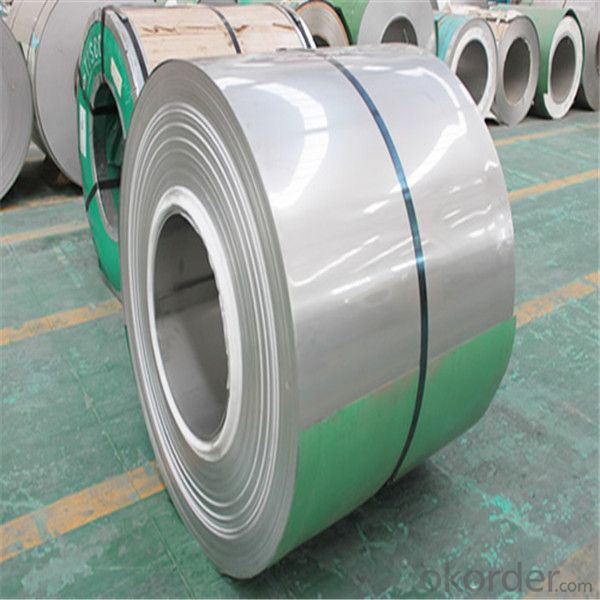

- Q: Can stainless steel strips be used in medical implants?
- Yes, stainless steel strips can be used in medical implants. Stainless steel is widely used in the medical industry due to its high strength, corrosion resistance, and biocompatibility, making it suitable for various implantable medical devices such as orthopedic implants, pacemakers, and surgical instruments.
- Q: Can stainless steel strips be electroplated?
- Certainly, it is possible to electroplate stainless steel strips. Electroplating involves the application of a slender metal layer onto an object's surface through the utilization of an electric current. While stainless steel is already resistant to corrosion, electroplating can augment its visual appeal, offer additional protection against wear and tear, and enhance its conductivity. The procedure encompasses submerging the stainless steel strip into a solution containing metal ions and subsequently applying an electric current, which results in the attraction and deposition of the metal ions onto the strip's surface. This technique can be employed with various metals, like gold, silver, nickel, or chromium, in order to achieve diverse aesthetic or functional qualities.
- Q: How do stainless steel strips perform in low temperature environments?
- Stainless steel strips perform exceptionally well in low temperature environments due to their inherent properties such as high strength, corrosion resistance, and toughness. They are capable of maintaining their structural integrity, durability, and resistance to brittleness even in extremely cold temperatures.
- Q: Can 111 stainless steel strips be coated or plated for added protection?
- Yes, 111 stainless steel strips can be coated or plated for added protection.
- Q: Why does the stainless steel after processing have magnetism?
- In addition, 304 stainless steel after cold processing, the structure of the structure will also change to martensite, and the greater the deformation degree of cold work, the more martensitic transformation, the greater the magnetic properties of steel. The stable austenite structure can be recovered by high temperature solution treatment so as to eliminate magnetism.
- Q: Are stainless steel strips resistant to chlorine corrosion?
- Yes, stainless steel strips are generally resistant to chlorine corrosion. Stainless steel is known for its high resistance to corrosion and staining, which makes it an ideal material for various applications that come into contact with chlorine, such as swimming pool equipment, water treatment plants, and chemical processing facilities. The addition of elements like chromium and nickel in stainless steel enhances its corrosion resistance, forming a passive oxide layer on the surface that protects the metal from the harmful effects of chlorine. However, it is important to note that the corrosion resistance of stainless steel can vary depending on the specific grade and composition of the alloy, as well as the concentration and temperature of the chlorine solution. Therefore, it is recommended to consult with a stainless steel expert or refer to the specific corrosion resistance charts provided by stainless steel manufacturers to ensure the suitability of stainless steel strips in a chlorine-rich environment.
- Q: What are the different types of edges for stainless steel strips?
- The different types of edges for stainless steel strips include mill edge, slit edge, deburred edge, and rounded edge.
- Q: Can stainless steel strips be used in marine vessel construction?
- Indeed, stainless steel strips find practical application in the construction of marine vessels. Offering exceptional resistance to corrosion, stainless steel emerges as an optimal alternative for marine purposes. Withstanding the corrosive nature of saltwater, stainless steel resists rusting and deterioration. In fact, stainless steel strips can be effectively employed in multiple sections of a marine vessel, encompassing the hull, deck, fittings, and equipment. Its robustness, strength, and unwavering resistance to corrosion render stainless steel a dependable material for crafting marine vessels capable of enduring the harsh oceanic conditions.
- Q: Can 111 stainless steel strips be used in the aerospace industry?
- Yes, 111 stainless steel strips can be used in the aerospace industry. Stainless steel is known for its excellent strength, corrosion resistance, and heat resistance properties, making it suitable for various applications in the aerospace industry. The 111 grade stainless steel is a variation of austenitic stainless steel, which offers good formability and weldability. It is commonly used in aerospace applications that require high strength and resistance to corrosion, such as aircraft components, engine parts, and structural components. However, it is important to note that the specific requirements and regulations of the aerospace industry may vary, so it is necessary to consult with industry experts and adhere to the relevant specifications and standards to ensure the suitability and safety of using 111 stainless steel strips in aerospace applications.
- Q: Are stainless steel strips resistant to scaling and oxidation?
- Yes, stainless steel strips are resistant to scaling and oxidation.
Send your message to us
Stainless Steel Coil and Sheet with Best Quality
- Loading Port:
- Shanghai
- Payment Terms:
- TT OR LC
- Min Order Qty:
- 3 m.t.
- Supply Capability:
- 100000 m.t./month
OKorder Service Pledge
OKorder Financial Service
Similar products
Hot products
Hot Searches
Related keywords
